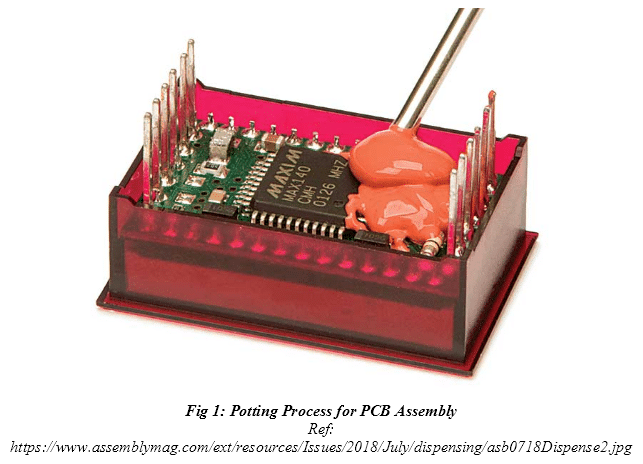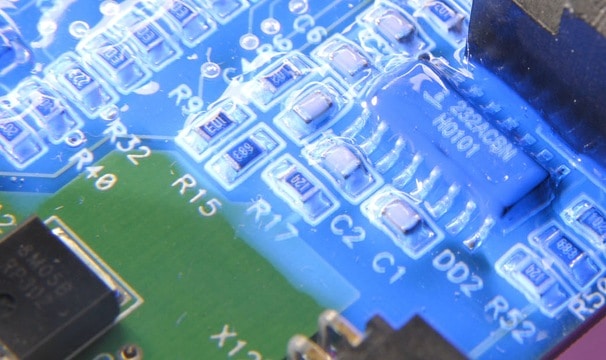Which is Better for PCBs — Potting or Conformal Coating?
For protecting a PCB, Rush PCB offers a few options—potting with encapsulation resins or conformal coatings. For both, we use organic polymers to provide the necessary chemical and thermal resistance, along with the inevitable electrical insulation to the PCB assembly. Although there are several similarities between the two, there are many differences as well. It is necessary to understand the differences between conformal coatings and encapsulation resins and their effects on the PCB assembly, to use them where they will offer maximum benefit.
Potting, encapsulation, or embedment protects the PCB assembly from its immediate surrounding environment. Potting adds a shell that encases the board, providing thermal management to the electronics it covers. For potting, it is necessary to place the PCB assembly within a suitable open box, and immerse the PCB and components in a liquid compound that the operator pours into the box. Once the liquid hardens, it encases the PCB assembly, making the box, and the hardened compound a part of the final product.
Conformal coatings are a protective, dielectric coating that manufacturers add on to a PCB assembly to provide an electrically non-conductive layer. As the name implies, the coating adheres to the PCB and components conforming to their outer shape. The layer adds significantly to the protection without increasing the weight or thickness of the PCB assembly.
Potting Versus Conformal Coating
Both potting and conformal coating aim for the same goal—to prevent damage to the PCB assembly from vibrations or effects of a harsh environment.
Both extend the life of the PCB assembly by shielding the components.
Both methods, when used in the right situation, can be equally effective, but they protect the PCB assembly in different ways.
Encapsulation of potting seals the PCB assembly with a thick layer of epoxy, adding substantial protection against chemical exposure and physical shock. Apart from this, it provides excellent electrical insulation. When dark colored, the epoxy does not allow visibility to the board or components underneath. As the applicator mixes a hardener with the resin before potting, the resin cures to form a cross-linked polymer or epoxy.
A conformal coating is a non-conducting protective dielectric layer that protects the board and components from corrosion, moisture, fungus, and salt spray. The thin film is lightweight, and does not have any dimensional effect on the PCB assembly, and does not add stress to the components. Traditional application is usually via a single-component spray, which makes conformal coating easy and versatile, offering flexible options.
Newer types of conformal coatings use two-part processes. To provide flexibility along with protection, the new types use polyurethane. The absence of solvents reduces concerns about VOCs or volatile organic compounds, typically present in several single-component causing adverse effects on the environment and people. However, awareness of the effects of VOCs is causing manufacturers to reduce these compounds in their coatings.
Which is Better for PCBs
For the best protection of the PCB assembly, several different factors need consideration. The most significant factor being environmental, consider whether the PCB assembly will face exposure to the following:
Extreme Temperatures: Choose the resin based on the temperature excursion. According to Rush PCB, resins behave differently under temperature extremes and rate of change. While mixing with its hardener, resins usually produce a huge amount of heat. The generated heat could damage the PCB and its components.
Moisture, Humidity, or Wetting: All conformal coatings are not the same, some being less waterproof than others are. Resins are usually waterproof, but the method of application and coating thickness may differ, and coatings with inadequate thickness may allow water ingress.
Vibration or Physical Shock: The presence of epoxy can help to absorb and spread the effect of vibration and physical shock, thereby eliminating the damage to the PCB assembly.
Abrasion and Scratches: High-speed assembly lines may subject the PCB assembly to mechanical stress such as abrasion and scratches. Epoxy provides a thick layer for protection against mechanical stress.
Chemical Exposure: Both epoxy and coatings provide exceptional protection to PCB and components from chemical exposure, saltwater spray, and immersion.
Although potting offers better protective advantages, coatings offer the designer more flexibility, while still providing significant protection in everyday environments. Encapsulation offers PCB assemblies operating in particularly challenging environments.
Advantages and Disadvantages
| Type of Covering | Advantages | Disadvantages |
| Potting/Encapsulation | When the PCB assembly needs protection from impacts, potting is the clear choice. Potting provides the best level of protection when the PCB assembly must withstand rough mechanical abrasion and/or potential impact damage. Potting also offers significant privacy and security, heat dissipation, and vibration damping.
Use of colored potting compounds can obscure the printed board and the components thereon. This prevents competitors from reverse engineering the product. |
Encapsulation creates a thick block over the PCB assembly. For applications with weight or thickness restrictions, potting may not be a suitable choice.
Difficult to inspect or rework the PCB assembly. Design issues due to the added thickness and weight. Application process is more complex—two-part mixing and generation of heat. |
| Conformal Coating | For applications with weight or thickness restrictions, conformal coating may be an excellent choice. As thinner and lighter electronic products are more popular, conformal coatings are the ideal option for situations where the space is a limitation, such as in mobile devices. | Conformal coatings do not protect against intellectual property thefts—does not prevent reverse engineering.
Less protection against heavy-duty threats. |
Conformal Coating Types:
Conformal coatings are typically available in five types:
Acrylic Resins: Popular, fungus resistant, can dry in room temperature within 30 minutes, excellent electrical and physical properties, can withstand up to 125 ºC.
Epoxy Resins: Two-component compounds, good resistance to humidity, chemicals, and high abrasion, extremely hard coating, tough, and durable, difficult to repair and rework.
Polyurethane Resins: Excellent humidity and chemical resistance, good dielectric properties, prevents tin-whisker growth, not good for high-heat and high-vibration environments.
Silicones: Good for high-temperature environments up to 200 ºC. Good resistance to humidity and corrosion, but less resistant to abrasion and solvents. Thicker layers can promote vibration damping.
Parylene: Requires vapor phase application process for polymerization. Exceptionally resilient, can withstand extremes in temperature and physical stress. Very thin coating possible, without pinholes.
Conclusion
Covering the PCB assembly with potting or conformal coatings is a complex process and has several variables such as effectiveness, turnaround time, and cost. Rush PCB has experts that help select the right protection for a specific project, timeline, and budget.



